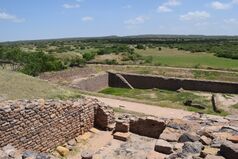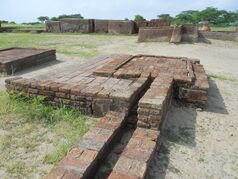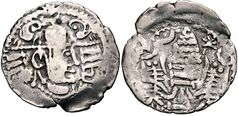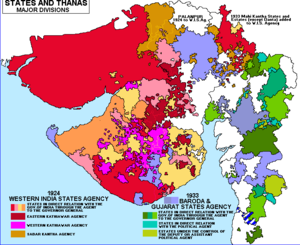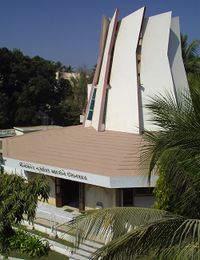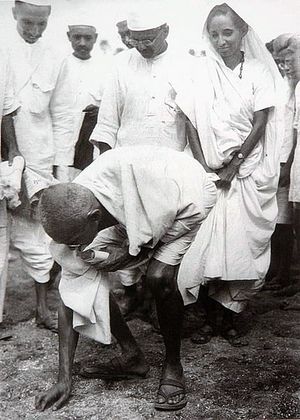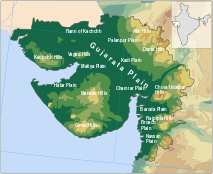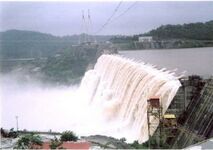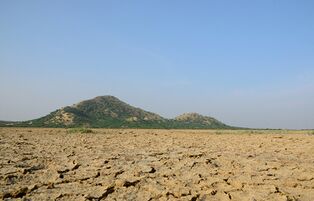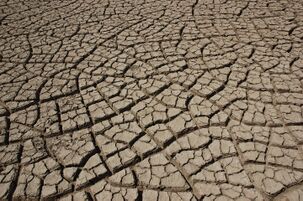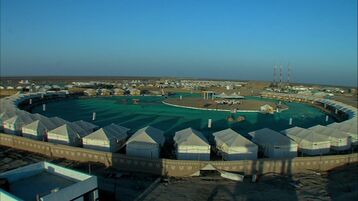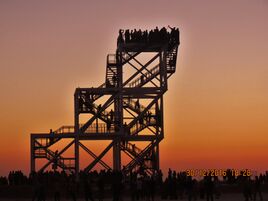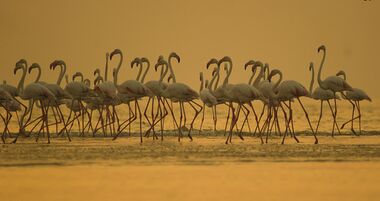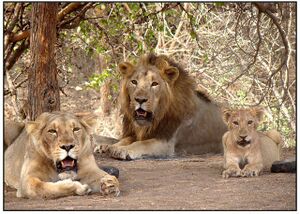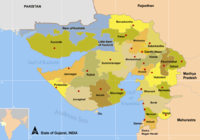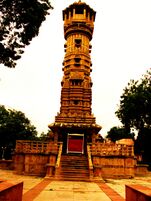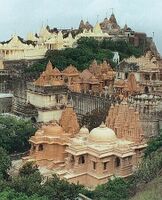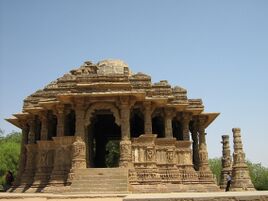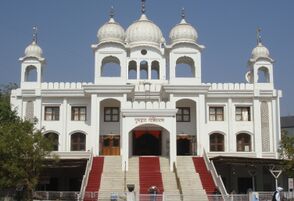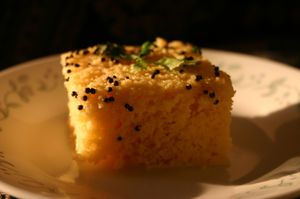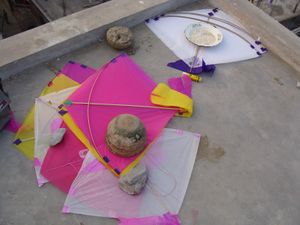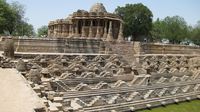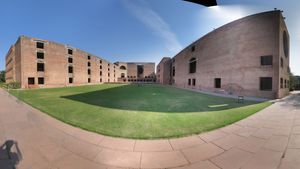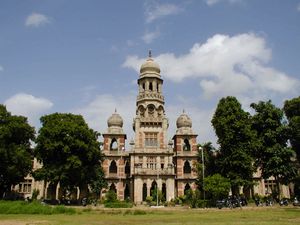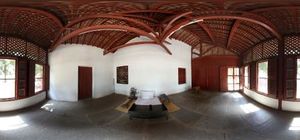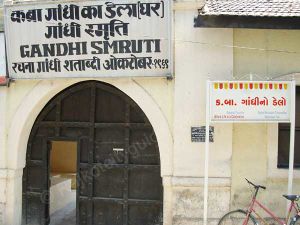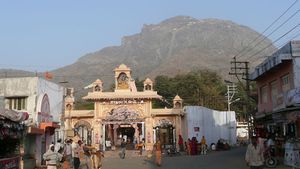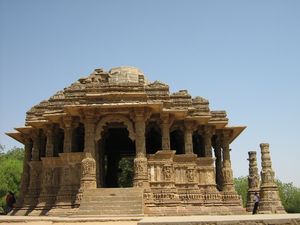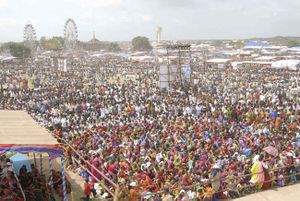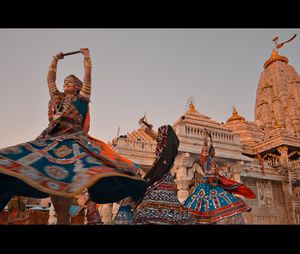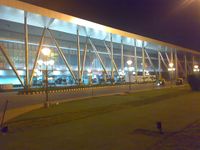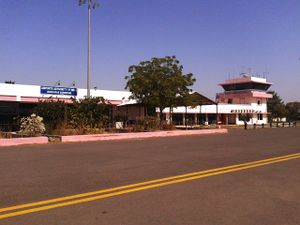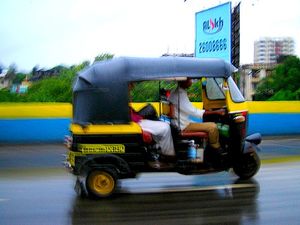گجرات
گجرات | |||||||||||||||||||||||||||||
|---|---|---|---|---|---|---|---|---|---|---|---|---|---|---|---|---|---|---|---|---|---|---|---|---|---|---|---|---|---|
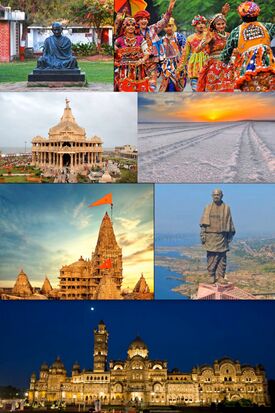 From top and L-R: Sabarmati Ashram, Gujarati attire, Somnath Temple, Rann of Kutch, Dwarkadhish Temple, Statue of Unity, Laxmi Vilas Palace at Vadodara | |||||||||||||||||||||||||||||
| أصل الاسم: Land of Gurjars | |||||||||||||||||||||||||||||
| الكنية: "جوهرة غرب الهند" | |||||||||||||||||||||||||||||
| الشعار: Satyameva Jayate (Truth alone triumphs) | |||||||||||||||||||||||||||||
| النشيد: Jai Jai Garavi Gujarat ("Victory to Proud Gujarat")[1] | |||||||||||||||||||||||||||||
 Location of گجرات in India | |||||||||||||||||||||||||||||
| الإحداثيات: 23°13′12″N 72°39′18″E / 23.220°N 72.655°E | |||||||||||||||||||||||||||||
| Country | |||||||||||||||||||||||||||||
| Region | West India | ||||||||||||||||||||||||||||
| Before was | Bombay State | ||||||||||||||||||||||||||||
| Formation (by bifurcation) | 1 May 1960 | ||||||||||||||||||||||||||||
| Capital | غاندينگر | ||||||||||||||||||||||||||||
| Largest City | أحمدآباد | ||||||||||||||||||||||||||||
| Largest Metro | Ahmedabad | ||||||||||||||||||||||||||||
| Districts | 33 | ||||||||||||||||||||||||||||
| الحكومة | |||||||||||||||||||||||||||||
| • الكيان | Government of گجرات | ||||||||||||||||||||||||||||
| • Governor | Acharya Devvrat | ||||||||||||||||||||||||||||
| • Chief Minister | Bhupendrabhai Patel (BJP) | ||||||||||||||||||||||||||||
| Legislature | Unicameral | ||||||||||||||||||||||||||||
| • Assembly | Gujarat Legislative Assembly (182 seats) | ||||||||||||||||||||||||||||
| National Parliament | Parliament of India | ||||||||||||||||||||||||||||
| • Rajya Sabha | 11 seats | ||||||||||||||||||||||||||||
| • Lok Sabha | 26 seats | ||||||||||||||||||||||||||||
| High Court | المحكمة العليا بگجرات | ||||||||||||||||||||||||||||
| المساحة | |||||||||||||||||||||||||||||
| • الإجمالي | 196٬024 كم² (75٬685 ميل²) | ||||||||||||||||||||||||||||
| ترتيب المساحة | 5th | ||||||||||||||||||||||||||||
| الأبعاد | |||||||||||||||||||||||||||||
| • الطول | 590 km (370 mi) | ||||||||||||||||||||||||||||
| • العرض | 500 km (300 mi) | ||||||||||||||||||||||||||||
| المنسوب | 137 m (449 ft) | ||||||||||||||||||||||||||||
| أعلى منسوب | 1٬145 m (3٬757 ft) | ||||||||||||||||||||||||||||
| أوطى منسوب | −1 m (−3 ft) | ||||||||||||||||||||||||||||
| التعداد (2011) | |||||||||||||||||||||||||||||
| • الإجمالي | ▲ 60٬439٬692 | ||||||||||||||||||||||||||||
| • الترتيب | 9th | ||||||||||||||||||||||||||||
| • الكثافة | 308/km2 (800/sq mi) | ||||||||||||||||||||||||||||
| • Urban | 42٫6% | ||||||||||||||||||||||||||||
| • Rural | 57٫4% | ||||||||||||||||||||||||||||
| صفة المواطن | Gujarati[3] • Hindi[4][5] | ||||||||||||||||||||||||||||
| Language | |||||||||||||||||||||||||||||
| • Official | Gujarati, Hindi | ||||||||||||||||||||||||||||
| • Official Script | Gujarati script, Devanagari script | ||||||||||||||||||||||||||||
| GDP | |||||||||||||||||||||||||||||
| • Total (2020-2021) | ▲₹16٫55 trillion (210 بليون US$) | ||||||||||||||||||||||||||||
| • Rank | 4th | ||||||||||||||||||||||||||||
| • Per capita | |||||||||||||||||||||||||||||
| منطقة التوقيت | UTC+05:30 (IST) | ||||||||||||||||||||||||||||
| ISO 3166 code | IN-GJ | ||||||||||||||||||||||||||||
| Vehicle registration | GJ | ||||||||||||||||||||||||||||
| HDI (2019) | |||||||||||||||||||||||||||||
| Literacy (2011) | ▲ 78.03%[8] (17th) | ||||||||||||||||||||||||||||
| Sex ratio (2011) | 919♀/1000 ♂[9] (16th) | ||||||||||||||||||||||||||||
| الموقع الإلكتروني | gujaratindia | ||||||||||||||||||||||||||||
| |||||||||||||||||||||||||||||
| ^† The state of Bombay was divided into two states i.e. Maharashtra and Gujarat by the Bombay (Reorganisation) Act 1960. | |||||||||||||||||||||||||||||
گجرات (إنگليزية: Gujarat؛ /ˌɡʊdʒəˈrɑːt/؛ گجراتي: ગુજરાત؛ Gujǎrāt؛ [ɡudʒ(ə)ɾat](![]() استمع)) هي ولاية في جمهورية الهند. وتنتج 19.8% من إجمالي الانتاج الصناعي للدولة، وهي أكثر الولايات تصنيعاً في الهند. ويحد گجرات پاكستان، وولايات راجستان إلى الشمال الشرقي، ماديا پرادش إلى الشرق, مهشراشترا والمناطق الاتحادية ديو، دمان، ددرا ونگر حولي إلى الجنوب. تاريخياً، كان يعرف باسم أنارتا، وشبه جزيرة كاثياواد، "سـَوراسترا"، والجنوب كان يعرف باسم "لاتا".[12] الحدود الدولية مع باكستان هي إلى الشمال الغربي. وبحر العرب هو ساحل الولاية الغربي. وعاصمتها، غاندينگر هي مدينة مخططة وتقع قرب أحمد أباد، العاصمة التجارية للولاية.
استمع)) هي ولاية في جمهورية الهند. وتنتج 19.8% من إجمالي الانتاج الصناعي للدولة، وهي أكثر الولايات تصنيعاً في الهند. ويحد گجرات پاكستان، وولايات راجستان إلى الشمال الشرقي، ماديا پرادش إلى الشرق, مهشراشترا والمناطق الاتحادية ديو، دمان، ددرا ونگر حولي إلى الجنوب. تاريخياً، كان يعرف باسم أنارتا، وشبه جزيرة كاثياواد، "سـَوراسترا"، والجنوب كان يعرف باسم "لاتا".[12] الحدود الدولية مع باكستان هي إلى الشمال الغربي. وبحر العرب هو ساحل الولاية الغربي. وعاصمتها، غاندينگر هي مدينة مخططة وتقع قرب أحمد أباد، العاصمة التجارية للولاية.
تضم الولاية مواقع رئيسية من حضارة وادي السند القديمة، مثل لوثال ودهولاڤيرا. ويُعتقد أن لوثال هو أحد أقدم موانئ العالم. مدن گجرات الساحلية، وخصوصاً بهاروچ وخامبهات، عملوا كموانئ ومراكز تجارية في امبراطوريتي موريا وگوپتا. مهاتما غاندي، الذي قاد حركة الاستقلال الهندية ضد الحكم الاستعماري البريطاني، كان گجراتياً.[13] محمد علي جناح، الأب المؤسس وأول حاكم عام لپاكستان كان من عائلة مسلمة گجراتية. سردار ڤالابهابهاي پاتل، أول نائب رئيس وزراء للهند المستقلة ووزير الداخلية، كان أيضا من گجرات.
The state encompasses 23 sites of the ancient Indus Valley civilisation (more than any other state). The most important sites are Lothal (the world's first dry dock), Dholavira (the fifth largest site), and Gola Dhoro (where 5 uncommon seals were found). Lothal is believed to have been one of the world's first seaports.[14] Gujarat's coastal cities, chiefly Bharuch and Khambhat,[15] served as ports and trading centres in the Maurya and Gupta empires, and during the succession of royal Saka dynasties in the Western Satraps era.[16][17] Along with Bihar, Mizoram and Nagaland, Gujarat is one of four Indian states to prohibit the sale of alcohol.[18] The Gir Forest National Park in Gujarat is home to the only wild population of the Asiatic lion in the world.[19]
The economy of Gujarat is the fourth-largest in India, with a gross state domestic product (GSDP) of ₹16٫55 trillion (يكافئ ₹19 trillion or 230 بليون US$ في 2023) and has the country's 10th-highest GSDP per capita of ₹215٬000 (US$2٬700).[6] Gujarat ranks 21st among Indian states and union territories in human development index.[20] Gujarat is regarded as one of the most industrialised states and has a low unemployment rate,[21] but the state ranks poorly on some social indicators and is at times affected by religious violence.[22]
. . . . . . . . . . . . . . . . . . . . . . . . . . . . . . . . . . . . . . . . . . . . . . . . . . . . . . . . . . . . . . . . . . . . . . . . . . . . . . . . . . . . . . . . . . . . . . . . . . . . . . . . . . . . . . . . . . . . . . . . . . . . . . . . . . . . . . . . . . . . . . . . . . . . . . . . . . . . . . . . . . . . . . . .
أصل الاسم
اشتق اسم گجرات المعاصر منگـُجـّار-راترا (شاوراسني من اللغة السنسكريتية گجرار-راشترا)، أمة گجرار.[23][24][25] ومنشأ الگجرار غير مؤكد. قام الگجرار بغزوات على شمال الهند في زمن الهونا. وكانت اسم تلك القبيلة التي غزت المنطقة "گرارارا".[26]
التاريخ
التاريخ القديم
Archaeological remains of washroom drainage system at Lothal |
Gujarat was one of the main central areas of the Indus Valley civilisation, which is centred primarily in modern Pakistan.[28] It contains ancient metropolitan cities from the Indus Valley such as Lothal, Dholavira and Gola Dhoro.[29] The ancient city of Lothal was where India's first port was established.[14] The ancient city of Dholavira is one of the largest and most prominent archaeological sites in India, belonging to the Indus Valley civilisation. The most recent discovery was Gola Dhoro. Altogether, about fifty Indus Valley settlement ruins have been discovered in Gujarat.[30]
The ancient history of Gujarat was enriched by the commercial activities of its inhabitants. There is clear historical evidence of trade and commerce ties with Egypt, Bahrain and Sumer in the Persian Gulf during the time period of 1000 to 750 BCE.[30][31] There was a succession of various Indian empires such as the Mauryan dynasty, Western Satraps, Satavahana dynasty, Gupta Empire, Chalukya dynasty, Rashtrakuta Empire, Pala Empire and Gurjara-Pratihara Empire, as well as the Maitrakas and then the Chaulukyas.
The early history of Gujarat includes the imperial grandeur of Chandragupta Maurya who conquered a number of earlier states in what is now Gujarat. Pushyagupta, a Vaishya, was appointed the governor of Saurashtra by the Mauryan regime. He ruled Girinagar (modern-day Junagadh) (322 BCE to 294 BCE) and built a dam on the Sudarshan lake. Emperor Ashoka the Great, the grandson of Chandragupta Maurya, not only ordered his edicts engraved in the rock at Junagadh, but also asked Governor Tusherpha to cut canals from the lake where an earlier Indian governor had built a dam. Between the decline of Mauryan power and Saurashtra coming under the sway of the Samprati Mauryas of Ujjain, there was an Indo-Greek defeat in Gujarat of Demetrius. In 16th century manuscripts, there is an apocryphal story of a merchant of King Gondophares landing in Gujarat with Apostle Thomas. The incident of the cup-bearer torn apart by a lion might indicate that the port city described is in Gujarat.[32][33]
For nearly 300 years from the start of the 1st century CE, Saka rulers played a prominent part in Gujarat's history. The weather-beaten rock at Junagadh gives a glimpse of the ruler Rudradaman I (100 CE) of the Saka satraps known as Western Satraps, or Kshatraps. Mahakshatrap Rudradaman I founded the Kardamaka dynasty which ruled from Anupa on the banks of the Narmada up to the Aparanta region bordering Punjab. In Gujarat, several battles were fought between the Indian dynasties such as the Satavahana dynasty and the Western Satraps. The greatest and the mightiest ruler of the Satavahana dynasty was Gautamiputra Satakarni who defeated the Western Satraps and conquered some parts of Gujarat in the 2nd century CE.[34]
The Kshatrapa dynasty was replaced by the Gupta Empire with the conquest of Gujarat by Chandragupta Vikramaditya. Vikramaditya's successor Skandagupta left an inscription (450 CE) on a rock at Junagadh which gives details of the governor's repairs to the embankment surrounding Sudarshan lake after it was damaged by floods. The Anarta and Saurashtra regions were both parts of the Gupta empire. Towards the middle of the 5th century, the Gupta empire went into decline. Senapati Bhatarka, the general of the Guptas, took advantage of the situation and in 470 set up what came to be known as the Maitraka state. He shifted his capital from Giringer to Valabhi, near Bhavnagar, on Saurashtra's east coast. The Maitrakas of Vallabhi became very powerful with their rule prevailing over large parts of Gujarat and adjoining Malwa. A university was set up by the Maitrakas, which came to be known far and wide for its scholastic pursuits and was compared with the noted Nalanda University. It was during the rule of Dhruvasena Maitrak that Chinese philosopher-traveler Xuanzang/ I Tsing visited in 640 along the Silk Road.[36]
Gujarat was known to the ancient Greeks and was familiar with other Western centers of civilisation through the end of the European Middle Ages. The oldest written record of Gujarat's 2,000-year maritime history is documented in a Greek book titled The Periplus of the Erythraean Sea: Travel and Trade in the Indian Ocean by a Merchant of the First Century.[37][38]
التاريخ القروسطي
 معبد سومناث، الشهير باسم "ضريح الخلود"، تدمرت وأعيد بناؤها 6 مرات. |
قبل الاستقرار النهائي في 1298، كان للمسلمين اتصال غير دائم بهذا الجزء من الهند. وكان ذلك إما لكون أولئك المسلمين بحارة أو تجار. وقد سُمح لهم بتأسيس مستوطنتين صغيرتين في كامباي (حاليا خامبهات) و برواچ (حاليا بهاروچ). جاء داعية من مصر، يدعى عبد الله، في عهد سيدهراج جايسينه وسُمح له بالدعوة، وإليه تنتسب طائفة البهرة. إلا أنه بعد هزيمة كاراندڤ ڤاغلا على يد علاء الدين خلجي، فقد حكم المسلمون لمدة 400 سنة.
1297–1614
من 1297 إلى 1300، دمر علاء الدين خلجي، سلطان دلهي، أنهيلوارا وضم گجرات إلى سلطنة دلهي. وبعد أن أضعف نهب تيمورلنك دلهي في نهاية القرن الرابع عشر السلطنة، نزع راجپوت گجرات المسلم، ظفر خان مظفر، إلى الاستقلال، وقام ابنه، السلطان إحسان شاه (حكم 1411 إلى 1442)، تنفيذا لحلم رآه في المنام، بإنشاء أحمدآباد كعاصمة، وظلت عاصمة وثاني أكبر مدن الهند (بعد دلهي) حتى عام 1960 حين تم نقل العاصمة إلى غاندينگر. وحلت كامباي محل بهاروچ كأهم ميناء تجاري في گجرات. ظلت سلطنة گجرات مستقلة حتى 1576، حين فتحها امبراطور المغل أكبر العظيم وضمها إلى امبراطورية المغل. ومنذ ذلك الحين أصبح ميناء سورات هو ميناء الهند البارز والرئيسي طيلة حكم المغل. وبقيت گجرات مقاطعة في امبراطورية المغل حتى احتلت ماراثا گجرات في بداية القرن الثامن عشر.
بعد أحمد شاه، جاء خلف محمود شاه، الذي كان حاكما قوياً وناجحاً في إخضاع معظم الراجپوتات. وكفاتح كان محمود قاسياً، إلا أنه كإداري كان فعالاً وكبنـّاء فقد كان عظيماً. كما تمكن محمود من مواجهة غارات البرتغاليين بأسطول بناه عبد له اسمه مالك عياذ بمساعدة شاهبندر تجار القلزم بمصر المملوكية، حسين الكردي. وقد أقام قاعدته البحرية في ديو مقابل ساحل ساوتراشترا.
سلطنة گجرات والتجار
For the best part of two centuries, the independent Sultanate of Gujarat was the cynosure of its neighbours on account of its wealth and prosperity, which had long made the Gujarati merchant a familiar figure in the ports of the Indian Ocean.[39] The merchants of Gujarat, both Hindu and Muslim, as well as the enterprising Parsi class, had been specialising in the organization of overseas trade for many centuries. By the 17th century, Baghdadi Jews and Chavuse had assimilated into the social world of the Surat province, later on their descendants would give rise to the Sassoons of Bombay and the Ezras of Calcutta.[40] At its zenith, Gujarati merchants with the aid of Khoja and Bohra shipowners, nakhudas, and lascars, had created the legacy of an international transoceanic empire which had a vast commercial network of agents stationed at all the great port cities across the Indian Ocean. These networks extended to الفلپين in the east, East Africa in the west, and via maritime and the inland caravan route to Russia in the north.[41]
As Tome Pires, a Portuguese official at Malacca, writing of conditions during the reigns of Mahmud I and Mozaffar II, expressed it: “Cambay stretches out two arms; with her right arm she reaches toward عدن and with the other towards Malacca” (Pires, I, p. 41). His contemporary, Duarte Barbosa, describing Gujarat’s maritime trade, recorded the import of horses from the Middle East and elephants from Malabar, and lists exports which included muslins, chintzes and silks, carnelian, ginger, and other spices, aromatics, opium, indigo, and other substances for dyeing, cereals, and legumes (Barbosa, I, pp. 108–58). Persia was the destination for many of these commodities, and they were partly paid for in horses and pearls taken from Hormuz (Barbosa, I, p. 82). It was the latter item, in particular, which led Sultan Sikandar Lodi of Delhi, according to ʿAli-Moḥammad Khan, author of the Merʾāt-e aḥmadi, to complain that the “support of the throne of Delhi is wheat and barley but the foundation of the realm of Gujarat is coral and pearls” (apud Bayley, p. 20). Hence, the sultans of Gujarat possessed ample means to sustain lavish patronage of religion and the arts, and to build madrasas, and ḵānaqāhs, and to provide douceurs for the literati, mainly poets and historians, whose presence and praise enhanced the fame of the dynasty.[42]
Even at the time of Tom Pires' travel to the East Indies in the early 16th-century, Gujarati merchants had a formidable reputation for their commercial acumen. Pires noted:[43]
These [people] are [like] Italians in their knowledge of and dealings in merchandise...they are men who understand merchandise; they are so properly steeped in the sound and harmony of it, that the Gujaratees say that any offence connected with merchandise is pardonable. There are Gujaratees settled everywhere. They work some for some and others for others. They are diligent, quick men in trade. They do their accounts with fingers like ours and with our very writings.
. . . . . . . . . . . . . . . . . . . . . . . . . . . . . . . . . . . . . . . . . . . . . . . . . . . . . . . . . . . . . . . . . . . . . . . . . . . . . . . . . . . . . . . . . . . . . . . . . . . . . . . . . . . . . . . . . . . . . . . . . . . . . . . . . . . . . . . . . . . . . . . . . . . . . . . . . . . . . . . . . . . . . . . .
گجرات وسلطنة المغل
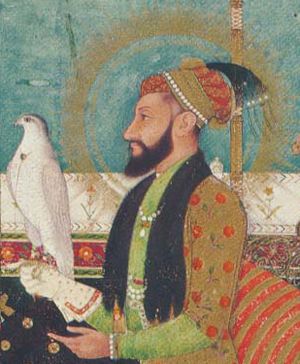
أورنگزيب, who was better known by his imperial title Alamgir ("world-tamer"), was born at Dahod, Gujarat, and was the sixth Mughal Emperor ruling with an iron fist over most of the Indian subcontinent. He was the third son and sixth child of Shah Jahan and Mumtaz Mahal. At the time of his birth, His father, Shah Jahan, was then the Subedar (governor) of Gujarat whilst his (Shah Jahan's) father, Jehangir, was the Mughal Emperor. Before he became emperor, Aurangzeb was made Subedar of Gujarat as part of his training and was stationed at Ahmedabad. Aurangzeb was a notable expansionist and was amongst the wealthiest of the Mughal rulers with an annual yearly tribute of £38,624,680 (في 1690). During his lifetime, victories in the south expanded the Mughal Empire to more than 3.2 million square kilometres and he ruled over a population estimated as being in the range of 100–150 million subjects.
Aurangzeb had great love for his place of birth. In 1704, he wrote a letter to his eldest son, Muhammad Azam Shah, asking him to be kind and considerate to the people of Dahod as it was his birthplace. Muhammad Azam was then the Subedar (governor) of Gujarat.
في رسالته، كتب أورنگزيب:[44]
ابني العزيز، بلدة دوهاد، إحدى توابع گجرات، هي مسقط رأس ذلك الخطاء. حبذا لو تأخذ ذلك في اعتبارك، فأهل تلك البلدة هم أيضاً يعوِّلون عليك.
1614–1947
بعد الاستقلال
الجغرافيا
Gujarat borders the Tharparkar, Badin and Thatta districts of Pakistan's Sindh province to the northwest, is bounded by the Arabian Sea to the southwest, the state of Rajasthan to the northeast, Madhya Pradesh to the east, and by Maharashtra, the Union Territory of Dadra and Nagar Haveli and Daman and Diu to the south. Historically, the north was known as Anarta, the Kathiawar peninsula, "Saurastra", and the south as "Lata".[45] Gujarat was also known as Pratichya and Varuna.[46] The Arabian Sea makes up the state's western coast. The capital, Gandhinagar is a planned city. Gujarat has an area of 75,686 sq mi (196,030 km2) with the longest coastline (24% of Indian sea coast) 1,600 km (990 mi), dotted with 41 ports: one major, 11 intermediate and 29 minor.
The Narmada is the largest river in Gujarat followed by the Tapi. The Sabarmati has the longest course through the state. The Sardar Sarovar Project is built on Narmada, one of the major rivers of peninsular India where it is one of only three major rivers that run from east to west – the others being the Tapi and the Mahi. It is about 1,312 km (815 mi) long. Several riverfront embankments have been built on the Sabarmati River.
The eastern borders have fringes of low mountains of India, the Aravalli, Sahyadri (Western Ghats), Vindhya and Saputara. Apart from this the Gir hills, Barda, Jessore and Chotila together make up a large minority of Gujarat. Girnar is the tallest peak and Saputara is the only hill-station (hilltop resort) in the state.
ران كوتش
Rann (રણ) is Gujarati for desert. The Rann of Kutch is a seasonally marshy saline clay desert in the Thar Desert biogeographic region between the Pakistani province of Sindh and the rest of the state of Gujarat; it commences 8 km (5.0 mi) from the village of Kharaghoda, Surendranagar District.
Mount Karo, كوتش
Cracked earth in the ران كوتش
The colourful Rann Utsav Festival is held annually in the ران كوتش.
Camel ride في ران كوتش
النبيت والوحيش
وحيش ما قبل التاريخ
In the early 1980s, palaeontologists found dinosaur egg hatcheries and fossils of at least 13 species in Balasinor. The most important find was that of a carnivorous abelisaurid named Rajasurus narmadensis which lived in the Late Cretaceous period.[47]
الأنواع المتواجدة
According to the India State of Forest Report 2011, Gujarat has 9.7% of its total geographical area under forest cover.[48] Among the districts, The Dangs has the largest area under forest cover. Gujarat has four national parks and 21 sanctuaries. It is the only home of Asiatic lions and, outside Africa, is the only present natural habitat of lions.[49] Gir Forest National Park in the southwest part of the state covers part of the lions' habitat. Apart from lions, Indian leopards are also found in the state. They are spread across the large plains of Saurashtra and the mountains of South Gujarat. Other National Parks include Vansda National Park, Blackbuck National Park, Velavadar and Narara Marine National Park, Gulf of Kutchh, Jamnagar. Wildlife sanctuaries include Wild Ass Wildlife Sanctuary, Nal Sarovar Bird Sanctuary, Porbandar Bird Sanctuary, Kutch Desert Wildlife Sanctuary, Kutch Bustard Sanctuary, Narayan Sarovar Sanctuary, Jessore Sloth Bear Sanctuary, Anjal, Balaram-Ambaji, Barda, Jambughoda, Khavda, Paniya, Purna, Rampura, Ratan Mahal, and Surpaneshwar.
In February 2019, a Bengal tiger claimed to be from Ratapani in Madhya Pradesh was spotted in the area of Lunavada in Mahisagar district, in the eastern part of the state,[50][51] before being found dead later that month, likely from starvation.[52]
. . . . . . . . . . . . . . . . . . . . . . . . . . . . . . . . . . . . . . . . . . . . . . . . . . . . . . . . . . . . . . . . . . . . . . . . . . . . . . . . . . . . . . . . . . . . . . . . . . . . . . . . . . . . . . . . . . . . . . . . . . . . . . . . . . . . . . . . . . . . . . . . . . . . . . . . . . . . . . . . . . . . . . . .
الموقع
تقع ولاية گجرات في شمال غرب الهند وعاصمتها غاندي نگر، التي سميت على اسم المهاتما غاندي. وهي ولاية تاريخية وصناعية، وتشمل جزء من اقليم بومباي. تجاور منطقة غاندي گجرات بحر العرب وپاكستان والولايات راجاستان، وماديا، وپراديش، مهاراشترا، ودادرا، ونگر هاڤلي.
أنهار گجرات
|
|
|
التقسيمات الادارية
في 1 مايو 1960، تأسست گجرات بعد انفصالها عن ولاية بومباي السابقة، وكانت تضم 17 مقاطعة. فيما بعد تم تقسيم هذه المقاطعات. ومنذ 2007، أصبحت الولاية تضم 26 مقاطعة.[53]
الديموغرافيا
Gujarat has 33 districts and 250 talukas.[54][55]
| Rank | District | Pop. | Rank | District | Pop. | ||||
|---|---|---|---|---|---|---|---|---|---|
 Ahmedabad  Surat |
1 | Ahmedabad | Ahmedabad | 6,357,693 | 11 | Morbi | Morbi | 210,451 |  Vadodara  Rajkot |
| 2 | Surat | Surat | 5,935,000 | 12 | Anand | Anand | 209,410 | ||
| 3 | Vadodara | Vadodara | 2,065,771 | 13 | Mehsana | Mehsana | 190,753 | ||
| 4 | Rajkot | Rajkot | 1,390,640 | 14 | Surendranagar Dudhrej | Surendranagar | 177,851 | ||
| 5 | Bhavnagar | Bhavnagar | 605,882 | 15 | Veraval | Gir Somnath | 171,121 | ||
| 6 | Jamnagar | Jamnagar | 479,920 | 16 | Navsari | Navsari | 171,109 | ||
| 7 | Junagadh | Junagadh | 319,462 | 17 | Bharuch | Bharuch | 169,007 | ||
| 8 | Gandhinagar | Gandhinagar | 292,167 | 18 | Vapi | Valsad | 163,630 | ||
| 9 | Gandhidham | Kutch | 248,705 | 19 | Porbandar | Porbandar | 152,760 | ||
| 10 | Nadiad | Kheda | 225,071 | 20 | Bhuj | Kutch | 148,834 | ||
الدين
Religion in Gujarat (2011)[56]
According to 2011 census, the religious makeup in Gujarat was 88.57% Hindu, 9.67% Muslim, 0.96% Jain, 0.52% Christian, 0.10% Sikh, 0.05% Buddhist and 0.03% others. Around 0.1% did not state any religion.[56] Hinduism is the majority religion, and is over 93% in rural areas. Muslims are the biggest minority in the state accounting for 9.7% of the population. Gujarat has the third-largest population of Jains in India, following Maharashtra and Rajasthan, almost all of whom live in urban areas like Ahmedabad and Surat.[57]
The Zoroastrians, also known in India as Parsi and Irani, migrated to Gujarat as refugees to escape adverse conditions and religious persecution from Islam in Persia in order to maintain their faith and traditions. They have also played an instrumental role in economic development, with several of the best-known business conglomerates of India run by Parsi-Zoroastrians, including the Tata, Godrej, and Wadia families. There is a small Jewish community centred around Magen Abraham Synagogue.
Modhera Sun Temple built by Bhimdev
Magen Abraham Jewish Synagogue
Jama Masjid (Friday Mosque, 15th century), Ahmedabad
| النمو السكاني | |||
|---|---|---|---|
| Census | Pop. | %± | |
| 1951 | 16٬263٬000 | ||
| 1961 | 20٬633٬000 | 26.9% | |
| 1971 | 26٬697٬000 | 29.4% | |
| 1981 | 34٬086٬000 | 27.7% | |
| 1991 | 41٬310٬000 | 21.2% | |
| 2001 | 50٬671٬000 | 22.7% | |
| 2011 | 60٬383٬628 | 19.2% | |
| المصدر:تعداد الهند[58] | |||
في تعداد 2011 كان عدد سكان ولاية گجرات 60,383,628 نسمة. وتبلغ الكثافة السكانية في الولاية 308/كم²، وهي كثافة منخفضة مقارنة بولايات الهند الأخرى. حسب تعداد 2011 كان عدد البنات 918 مقابل 1000 ولد.
حوالي 89.1% من سكان ولاية گجرات من الهندوس.[59] يمثل المسلمون 9.1%، الجيان 1.0%، السيخ 0.1%، والمسيحية 0.01% من السكان.[59]
اللغة
Gujarati is the official language of the state. It is spoken natively by 86% of the state's population, or 52 million people (as of 2011). Hindi is the second-largest language, spoken by over 6% of the population. Marathi is also spoken in urban areas.[60]
People from the Kutch region of Gujarat also speak in the Kutchi mother tongue, and to a great extent understand Sindhi as well. Memoni is the mother tongue of Kathiawar and Sindhi Memons, most whom are Muslims.
Almost 88% of the Gujarati Muslims speak Gujarati as their mother tongue, whilst the other 12% speak Urdu. A sizeable proportion of Gujarati Muslims are bilingual in the two languages; Islamic academic institutions (Darul Uloom) place a high prestige on learning Urdu and Arabic, with students' memorising the Quran and ahadith, and emphasising the oral and literary importance of mastering these languages as a compulsory rite of religion.
In rural areas among the tribals, various Bhil dialects are spoken by around 1.37% of the population. In the northeast, Bhili is spoken, in the central part is spoken Bhili, Bhilali and Vasava, while in the southeast is spoken Dangi, Varli Chodri and Dhodia which are related to Marathi.
Apart from this, English, Bengali, Kannada, Malayalam, Marwari, Odia, Punjabi, Tamil, Telugu and others are spoken by a considerable number of economic migrants from other states of India seeking employment.[61]
The languages taught in schools under the three-language formula are:[62]
First language: Gujarati/Hindi/English
Second language: Gujarati/English
Third language: Hindi
الحكومة والادارة
 مقالة مفصلة: رؤساء وزراء گجرات
مقالة مفصلة: رؤساء وزراء گجرات
| الحيوان | الأسد |
|---|---|
| الطائر | الفلامنگو الكبير |
| الزهرة | ماريگولد |
| الشجرة | شجرة البانيان (گجراتي: 'વડ') |

الاقتصاد
الصناعة
تعتبر ولاية گجرات واحدة من أبرز الولايات الصناعية في الهند حيث ينمو قطاع الخدمات مع الصناعات بشكل هائل ما أدى إلى الازدهار لشعبها. لعب قطاع الصناعات التحويلية دورا هاما في نمو هذه الولاية وتطويرها فضلا عن المشاريع الصغيرة والمتوسطة التي هي الأخرى لعبت دورا رئيسيا في تشكيل الصناعات التحويلية في هذه الولاية.
الحلي والمجوهرات
كما يعد قطاع الأحجار الكريمة والمجوهرات واحدا من أسرع القطاعات نموا في البلاد وتعتبر ولاية گجرات ثاني أكبر منتج للذهب والمجوهرات في العالم وتساهم في أعلى نصيب (85 في المائة) من أجمالي الإنتاج الوطني من المجوهرات. وتصقل ثمانية من أصل 10 الماس في العالم في مدينة سورات التي تعروف باسم 'عاصمة الماس في العالم' حيث يقع أكبر محور في العالم لمعالجة الماس ممثلا 72 في المائة من إنتاج العالم و 80 في المائة من السوق الهندية.[64]
الصناعات الكيمياوية
كما سجل قطاع المواد الكيميائية بنسبة 53 في المائة من الإنتاج الوطني في الفترة ما بين 2005-2006 وتعد الولاية إحدى اكثر الولايات الهندية مساهمة في المنسوجات الصناعية في البلاد بنسبة وقدرها 31 في المائة.
وصلت نسبة الولاية من الإنتاج الوطني للأدوية إلى 28 في المائة ما بين 2006-2007 وبلغت قيمة الصادرات منها 1.4 مليار دولار (2006-07).
منتجات الألبان
وكذلك سجل اتحاد تسويق الحليب ومنتجات الألبان المعروف بـ (GCMMF) ، وهو شركة تعاونية عملاقة، مبيعات بقيمة 1.05 مليار دولار خلال السنة المالية 2006-07 ليصبح بذلك أول شركة تعاونية ذات مليار دولار في الهند.
اللغات
لغتها الرسمية والأساسية هي الگجراتي.
الثقافة
الديانات
| الديانة | السكان[65] |
|---|---|
| هندوس | 89.09% |
| مسلمون | 9.06% |
| الجاينيون | 1.03% |
| مسيحيون | 0.5% |
| سيخ | 0.19% |
| بوذيون | 0.07% |
| آخرون | 0.05% |
 مقالة مفصلة: مسلمو گجرات
مقالة مفصلة: مسلمو گجرات
يدين نحو 89.1% من سكان گجرات بالهندوسية. [66] المسلمون تبلغ نسبتهم 9.1%، الجاينيون 1.0% والسيخ 0.1% من السكان. [67] معظم الهندوس الگجراتيين نباتيون بصرامة. وبين الهنوس فإن الإله كريشنا يـُعبد في صورة شري ناثجي في جميع أرجاء گجرات.
التعليم
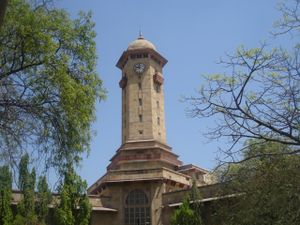
الحياة الحيوانية والنباتية
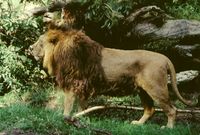
حديقة بالاسينور للديناصورات
السياحة
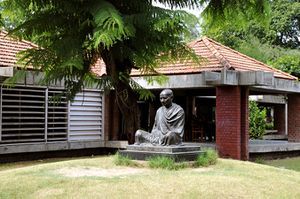
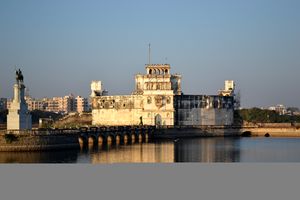

النقل
الجوي
يوجد في گجرات سبعت مطارات. تأسست هيئة الطيران المدني في گجرات لتطوير البنية التحتية للطيران في گجرات. يترأس الهيئة رئيس وزراء.[68]
- مطار ساردار ڤالابهابهاي پاتل الدولي، أحمد أباد، وتنطلق منه رحلات طيران داخلية ودولية.
- مطار سورات، مطار رحلات داخلية.
- مطار بهاڤنگر، مطار رحلات داخلية.
- مطار ديسا، مطار رحلات داخلية.
- مطار كاندلا، مطار رحلات داخلية.
- مطار كـِشود، مطار رحلات داخلية.
- مطار پوربندار، مطار رحلات داخلية.
- مطار راجكوت، مطار رحلات داخلية.
- مطار ڤادودارا، مطار رحلات داخلية.
- مطار بهوت، مطار دولي.
- مطار جامنگر، مطار دولي.
- قاعدة ناليا الجوية، قاعدة للاستخدام العسكري فقط.
- مطار مهسنانا، مطار تابع لحكومة الولاية.
- مطار ماندڤ، مطار تابع لحكومة الولاية.
- مطار أمرلي، مطار تدريب تابع لحكومة الولاية.
السكك الحديدية
النقل البحري
النقل البري
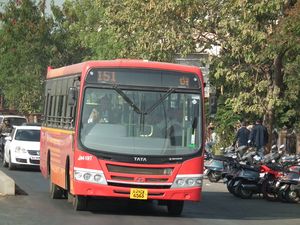
انظر أيضاً
- الهند
- موضوعات عن الهند
- الشعب الگجراتي
- غاندينگر
- أحمد أباد
- سورات
- قائمة أشخاص من گجرات
- مهاتما غاندي
- ڤالابهابهاي پاتـِل
- نارندرا مودي
- زلزال گجرات 2001
- گجرات النابضة بالحياة - قمة المستثمرين العالميين
- پارسي
المصادر
- ^ "Newest version of Jay Jay Garvi Gujarat song launched(Video)". DeshGujarat. 7 May 2011. Archived from the original on 13 November 2016. Retrieved 12 November 2016.
- ^ "DGFASLI REPORT". Archived from the original on 20 August 2017. Retrieved 24 March 2023.
- ^ "50th Report of the Commissioner for Linguistic Minorities in India" (PDF). 16 July 2014. p. 118. Archived from the original (PDF) on 8 July 2016. Retrieved 6 November 2016.
- ^ "The Gujarat Official Languages Act, 1960" (PDF). indiacode.nic.in. 1961. Retrieved 21 December 2022.
- ^ Benedikter, Thomas (2009). Language Policy and Linguistic Minorities in India: An Appraisal of the Linguistic Rights of Minorities in India. LIT Verlag Münster. p. 89. ISBN 978-3-643-10231-7. Archived from the original on 25 April 2016. Retrieved 13 June 2018.
- ^ أ ب "Socio-Economic Review 2021–2022" (PDF). Government of Gujarat. p. 30. Retrieved 11 February 2022.[dead link]
- ^ "Human Development Indices (5.0)". Archived from the original on 17 February 2022. Retrieved 17 February 2022.
- ^ "Household Social Consumption on Education in India" (PDF). Archived from the original (PDF) on 2 November 2020. Retrieved 17 February 2022.
- ^ "Census 2011 (Final Data) – Demographic details, Literate Population (Total, Rural & Urban)" (PDF). planningcommission.gov.in. Planning Commission, Government of India. Archived from the original (PDF) on 27 January 2018. Retrieved 3 October 2018.
- ^ أ ب ت "Gujarat forgets state bird, tree and flower". The Times of India. 14 January 2016. Archived from the original on 27 December 2016. Retrieved 14 July 2017.
- ^ "Which is State Fruit of Gujarat India – Mango (Keri)". Nri Gujarati News. Archived from the original on 1 December 2017. Retrieved 14 July 2017.
- ^ P. Page xvii Historical and Cultural Chronology of Gujarat edited by Manjulal Ranchholdlal Majmudar
- ^ "Modern Gujarat". Mapsofindia.com. Retrieved 16 July 2010.
- ^ أ ب Kulke, Professor of Asian History Hermann; Kulke, Hermann; Rothermund, Dietmar (2004). A History of India (in الإنجليزية). Psychology Press. pp. 26–27. ISBN 978-0-415-32920-0. Archived from the original on 23 September 2021. Retrieved 2 August 2021.
- ^ Baṭṭūṭa, Ibn; Husain, Mahdi (1976). The Rehla of Ibn Battuta (India, Maldive Islands and Ceylon). Baroda: Oriental Institute. p. 172.
- ^ David Smith (2003). Hinduism and modernity. Oxford: Blackwell. p. 62. ISBN 978-0-631-20862-4.
Surat was then the place of embarkation of pilgrims to Mecca; known as Bab al-Makkah or the Gate of Mecca, it was almost a sacred place for the Muslims of India. More to the point it was the main city for foreign imports, where many merchants had their bases, and all the European trading companies were established. Its population was more than 100, 000.
- ^ The journal of Asian studies, Volume 35, Issues 1–2. 1975. Archived from the original on 4 March 2019. Retrieved 22 December 2016.
For a pious emperor, Surat had more than economic and political importance; it was the port from which the hajj (pilgrimage) ships left Mughal India for the Red Sea. The port was variously known as Bab-al-Makkah, the Bab-ul-Hajj, the Dar-al-Hajj, and the Bandar-i-Mubarak.
- ^ "States with total and phase-wise prohibition of alcohol in India". The Indian Express (in الإنجليزية). 6 April 2016. Archived from the original on 5 June 2021. Retrieved 2 August 2021.
- ^ Mukherjee, Aeshita; Borad, C.K. (1 October 2004). "Integrated approach towards conservation of Gir National Park: the last refuge of Asiatic Lions, India". Biodiversity & Conservation (in الإنجليزية). 13 (11): 2165–2182. doi:10.1023/B:BIOC.0000040009.75090.8c. ISSN 1572-9710. S2CID 35893400. Archived from the original on 25 September 2022. Retrieved 2 August 2021.
- ^ "Sub-national HDI – Area Database". Global Data Lab. Institute for Management Research, Radboud University. Archived from the original on 23 September 2018. Retrieved 25 September 2018.
- ^
- "Periodic Labour Force Survey (2017-18)" (PDF). Ministry of Labour and Employment. p. 212. Archived from the original (PDF) on 4 July 2019. Retrieved 3 May 2019.
- M Saraswathy (5 February 2020). "Electronic appliance makers eye Gujarat as new manufacturing hub". CNBC TV18. Archived from the original on 5 February 2020. Retrieved 4 March 2017.
- Pradeep Udhas. "Accelerating growth in Gujarat" (PDF). KPMG. Archived (PDF) from the original on 23 September 2020. Retrieved 4 July 2020.
- Tomar, Anita; Oza, Heena (September 2015). "Green supply chain management practices implementation and effect on organizational performance of ISO14001 certified manufacturing companies of India". Abhinav International Monthly Refereed Journal of Research in Management & Technology. Abhinav Publication. 4 (9): 21. ISSN 2320-0073. Retrieved 5 July 2020.
- ^
- Parwez, S. (2016). A Comparative Study of Gujarat and Kerala Developmental Experiences. International Journal of Rural Management, 12(2), 104–124. DOI:10.1177/0973005216660908
- Christophe Jaffrelot (2015) What 'Gujarat Model'?—Growth without Development—and with Socio-Political Polarisation, South Asia: Journal of South Asian Studies, 38:4, 820-838, DOI:10.1080/00856401.2015.1087456
- KALAIYARASAN, A. "A Comparison of Developmental Outcomes in Gujarat and Tamil Nadu." Economic and Political Weekly, vol. 49, no. 15, 2014, pp. 55–63. JSTOR, JSTOR 24479122. Accessed 29 Dec. 2022.
- Simpson, E. (2006). The State of Gujarat and the Men without Souls. Critique of Anthropology, 26(3), 331–348. DOI:10.1177/0308275X06066581
- SUD, N. (2008). Secularism and the Gujarat State: 1960–2005. Modern Asian Studies, 42(6), 1251-1281. DOI:10.1017/S0026749X07002934
- Subramaniam, M. (2014), "Resisting gendered religious nationalism: The case of religious-based violence in Gujarat, India", Gendered Perspectives on Conflict and Violence: Part B (Advances in Gender Research, Vol. 18B), Emerald Group Publishing Limited, Bingley, pp. 73-98. DOI:10.1108/S1529-21262014000018B007
- Ahmad, Riaz. "Gujarat Violence: Meaning and Implications." Economic and Political Weekly, vol. 37, no. 20, 2002, pp. 1870–73. JSTOR, JSTOR 4412121. Accessed 29 Dec. 2022.
- ^ Kumar Suresh Singh (2003). Anthropological Survey of India. Popular Prakashan. ISBN 978-81-7991-104-4.
{{cite book}}: Unknown parameter|coauthor=ignored (|author=suggested) (help) - ^ Gujrat Government. "Gujrat state official site".
The State took its name from the Gujara, the land of the Gujjars, who ruled the area during the 700's and 800's.
- ^ Ramesh Chandra Majumdar (1954). The History and Culture of the Indian People:The classical age. G. Allen & Unwin. p. 64.
.
{{cite book}}: Unknown parameter|coauthor=ignored (|author=suggested) (help) - ^ Bhandarkar, Devadatta Ramakrishna (1989). Some Aspects of Ancient Indian Culture. Asian Educational Services. p. 64. ISBN 81-206-0457-1.
- ^ Shuichi Takezawa (August 2002). "Stepwells – Cosmology of Subterranean Architecture as seen in Adalaj" (PDF). Journal of Architecture and Building Science. 117 (1492): 24. Archived (PDF) from the original on 20 July 2011. Retrieved 18 November 2009.
- ^ "Devdutt Pattanaik explores Gujarat through the ages and finds, in its archaeology, its myths and legends, its cultures and histories, a microcosm of the multilayered country he loves". 18 October 2017. Archived from the original on 27 October 2017. Retrieved 27 October 2017.
- ^ "Where does history begin?". 18 October 2017. Archived from the original on 27 October 2017. Retrieved 27 October 2017.
- ^ أ ب "History of Gujarat". Mapsofindia.com. Archived from the original on 26 May 2010. Retrieved 16 July 2010.
- ^ S. R. Rao (1985). Lothal. Archaeological Survey of India. p. 11.
- ^ The Acts of Judas Thomas, M.R. James, Tr. by M.R. James, Oxford: Clarendon Press, 1924.
- ^ Medlycott, A. E. India and the Apostle Thomas Archived 24 سبتمبر 2015 at the Wayback Machine
- ^ Trade And Trade Routes In Ancient India, von Moti Chandra, page: 99
- ^ "CNG: eAuction 343. INDIA, Post-Gupta (Gujura Confederacy). Gujuras of Sindh. Circa AD 570-712. AR Drachm (25 mm, 3.84 g, 9h)". cngcoins.com. Archived from the original on 11 August 2017. Retrieved 15 July 2017.
- ^ Mote, Sally Hovey Wriggins; with a foreword by Frederick W. (1996). Xuanzang : a Buddhist pilgrim on the Silk Road. Boulder, Colo.: Westview Press. ISBN 978-0-8133-2801-0. Archived from the original on 4 March 2019. Retrieved 22 December 2016.
{{cite book}}: CS1 maint: multiple names: authors list (link) - ^ Vashi, Ashish (21 October 2010), Saga of Barygaza, http://articles.timesofindia.indiatimes.com/2010-10-21/ahmedabad/28239734_1_bharuch-port-book, retrieved on 19 August 2014, ""The book describes an episode of a foreigner bringing costly gifts for kings, saying, "And for the King there are very costly vessels of silver, singing boys, beautiful maidens for the harem, fine wines, thin clothing of the finest weaves, and the choicest ointments.""
- ^ William H. Schoff (1912) (digitalized), The Periplus of the Erythraean Sea: Travel and Trade in the Indian Ocean by a Merchant of the First Century, New York, http://depts.washington.edu/silkroad/texts/periplus/periplus.html, retrieved on 1 October 2013, "As a sign of these places to those approaching from the sea there are serpents, very large and black; for at the other places on this coast and around Barygaza, they are smaller, and in color bright green, running into gold ... Now the whole country of India has very many rivers, and very great ebb and flow of the tides; increasing at the new moon, and at the full moon for three days, and falling off during the intervening days of the moon. But about Barygaza it is much greater, so that the bottom is suddenly seen, and now parts of the dry land are sea, and now it is dry where ships were sailing just before; and the rivers, under the inrush of the flood tide, when the whole force of the sea is directed against them, are driven upwards more strongly against their natural current, for many stadia."
- ^ Mehta, Makrand (11 January 1991). Indian Merchants and Entrepreneurs in Historical Perspective. Academic Foundation. p. 1. ISBN 81-7188-017-7. Retrieved 12 March 2013.
- ^ http://www.jcpa.org/jl/jl101.htm Lentin, Samuel Sifra (ed) Shalva Weil. " The Jewish Presence in Bombay." India's Jewish Heritage: Ritual, Art and Life-Style. Marg Publications:Mumbai. 2009.
- ^ Rajesh Rai, Peter Reeves, ed. (2008). The South Asian Diaspora: Transnational Networks and Changing Identities. Routledge. p. 1. ISBN 9781134105953. Retrieved 4 October 2013.
- ^ GUJARAT – Encyclopaedia Iranica. Iranicaonline.org. Retrieved on 28 July 2013.
- ^ Rajesh Rai, Peter Reeves, ed. (2008). The South Asian Diaspora: Transnational Networks and Changing Identities. Routledge. p. 31. ISBN 1134105959. Retrieved 4 October 2013.
- ^ Ashish Vashi (1 May 2012). "Aurangzeb loved Dahod till the end". dnaindia.com. Retrieved 4 October 2013.
Eminent historian Manekshah Commissariat has quoted from this letter in his book 'A History of Gujarat: Mughal period, from 1573 to 1758'.
- ^ P. Page xvii Historical and Cultural Chronology of Gujarat edited by Manjulal Ranchholdlal Majmudar
- ^ P. 391 The Hindu World: An Encyclopedic Survey of Hinduism by Benjamin Walker
- ^ The dinosaur wonders of India's Jurassic Park Archived 10 مايو 2012 at the Wayback Machine. BBC News. 11 May 2010.
- ^ "Forest and tree resources in states and union territories" (PDF) (Press release). Forest survey of India (Ministry of Environment and Forests). Archived from the original (PDF) on 23 May 2012. Retrieved 28 February 2014.
- ^ Singh, H. S.; Gibson, L. (2011). "A conservation success story in the otherwise dire megafauna extinction crisis: The Asiatic lion (Panthera leo persica) of Gir forest" (PDF). Biological Conservation. 144 (5): 1753–1757. doi:10.1016/j.biocon.2011.02.009. Archived from the original (PDF) on 8 August 2017. Retrieved 18 July 2017.
- ^ "Like humans, animals too have a right to migrate". The Hindustan Times. 18 February 2019. Archived from the original on 27 February 2019. Retrieved 17 March 2019.
- ^ Ghai, Rajat (12 February 2019). "Camera trap proves Gujarat now has tiger". Down To Earth. Archived from the original on 12 February 2019. Retrieved 17 March 2019.
- ^ Kaushik, Himashu (9 March 2019). "Tiger that trekked from MP to Gujarat died of starvation: Post-mortem report". The Times of India. Archived from the original on 28 February 2020. Retrieved 17 March 2019.
- ^ "LIST OF RECIPIENTS OF BHARAT RATNA" (PDF). Ministry of Home Affairs (India). Retrieved 27 February 2012.
- ^ "Village Map - Revenue Department". Internet Archive. 25 March 2016. Archived from the original on 25 March 2016. Retrieved 9 April 2016.
{{cite web}}: CS1 maint: unfit URL (link) - ^ "State Govt Announces 23 New Talukas". 10 September 2013. Archived from the original on 6 February 2016. Retrieved 5 January 2016 – via HighBeam Research.
- ^ أ ب "Population by religion community – 2011". Census of India, 2011. The Registrar General & Census Commissioner, India. Archived from the original on 25 August 2015.
- ^ "Table C-01 Population by Religion: Gujarat". censusindia.gov.in. Registrar General and Census Commissioner of India. 2011.
- ^ "Census Population" (PDF). Census of India. Ministry of Finance India. Retrieved 18 December 2008.
- ^ أ ب Indian Census
- ^ "Table C-16 Population by Mother Tongue: Gujarat". censusindia.gov.in. Registrar General and Census Commissioner of India.
- ^ "C-16 Population By Mother Tongue - Gujarat". censusindia.gov.in. Archived from the original on 6 July 2022. Retrieved 6 July 2022.
- ^ "52nd Report of the Commissioner for Linguistic Minorities in India" (PDF). nclm.nic.in. Ministry of Minority Affairs. 29 March 2016. p. 96. Archived from the original (PDF) on 25 May 2017. Retrieved 15 February 2018.
- ^ Robyn Meredith (16 April 2007). "The Next People's Car". Forbes. Retrieved 17 January 2011.
- ^ نبذة عن ولاية غوجارات، أخبار الهند
- ^ خطأ استشهاد: وسم
<ref>غير صحيح؛ لا نص تم توفيره للمراجع المسماةتعداد الهند - ^ http://www.censusindia.net/religiondata/ 2001 Indian Census Data
- ^ http://www.censusindia.net/religiondata/ 2001 Indian Census Data
- ^ "Gujarat Civil Aviation Policy 2010" (PDF). Government of Gujarat. Retrieved 19 April 2012.
وصلات خارجية
- الحكومة
- أخرى
 Gujarat travel guide from Wikivoyage
Gujarat travel guide from Wikivoyage- Gujarat at the Open Directory Project
- Pages using gadget WikiMiniAtlas
- Articles with dead external links from February 2023
- CS1 errors: unsupported parameter
- CS1 maint: unfit URL
- Short description is different from Wikidata
- Coordinates on Wikidata
- Pages using infobox place symbols with unknown parameters
- Pages using infobox Indian state or territory with unknown parameters
- Articles containing إنگليزية-language text
- Pages using Lang-xx templates
- Articles containing گجراتي-language text
- Articles with hatnote templates targeting a nonexistent page
- Pages using multiple image with auto scaled images
- Pages with empty portal template
- Portal-inline template with redlinked portals
- گجرات
- ولايات وأقاليم الهند
- دول ومناطق تأسست في 1960


